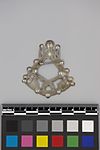Brooch
About this object
History of use
Silver ornaments represent an important part of early exchange between Europeans, including fur traders, and First Nations people, especially in Eastern and Central Canada and the USA. Initially, the main source of silver was British, French and Spanish coins. Most ornaments were produced by silversmiths of European origin in North America and Europe, and were actively traded only from 1760 to 1821. By the mid-18th century silver objects were produced in New England, Quebec and Montreal. Silver was used by First Nations people as a sign of rank. Silver ornaments in these styles continue to be produced by native silversmiths in central Canada and the USA. Brooches were the most popular and numerous silver ornaments. They were worn on the chest, but also in the hair. Frequently, many were worn at once in rows across the chest.
Watson dealt with the XY Company. In 1798 a group of Montreal traders formed the New North West Company to compete wit the North West Company (NWC). The former was dubbed the XY Company after the insignia on its kegs and bales of furs. When former NWC partner, Alexander Mackenzie, joined the XY Company, the name was changed to Alexander Mackenzie and Company. In 1804 the two companies merged under the NorthWest Company name. Newman, Peter Co. "Empire of the Bay", Viking 1985.
Cultural context
trade, personal decoration; status
Iconographic meaning
Secret Masonic emblem of compass and square adopted by Iroquois to represent the “Council fire”, a meeting of chiefs. The Freemasons' symbols are plumb, compass, square, level. The Masonic-type brooch may have been introduced by Mohawk Iroquois Chief, Joseph Brant, who in 1775 became a member of the Masonic Order in London.
Specific techniques
Repousse is a type of ornamentation formed in relief in metal by hammering up from the reverse or inner side.
Physical description
Masonic-style brooch with central diamond-shaped cutout, 4 semi-circular, 2 triangular and 3 irregular cutouts. Decorated with 14 small bosses and one large boss at top. Cross-pin attached. Maker’s mark.
Categories
Materials
Date Made
Fur Trade (1760-1821)
Date Acquired
9 Sep 1993
How Acquired
Donated
Credit Line
Measurements
Overall: 5 cm x 4.5 cm x .4 cm
Object Number
1590/111
